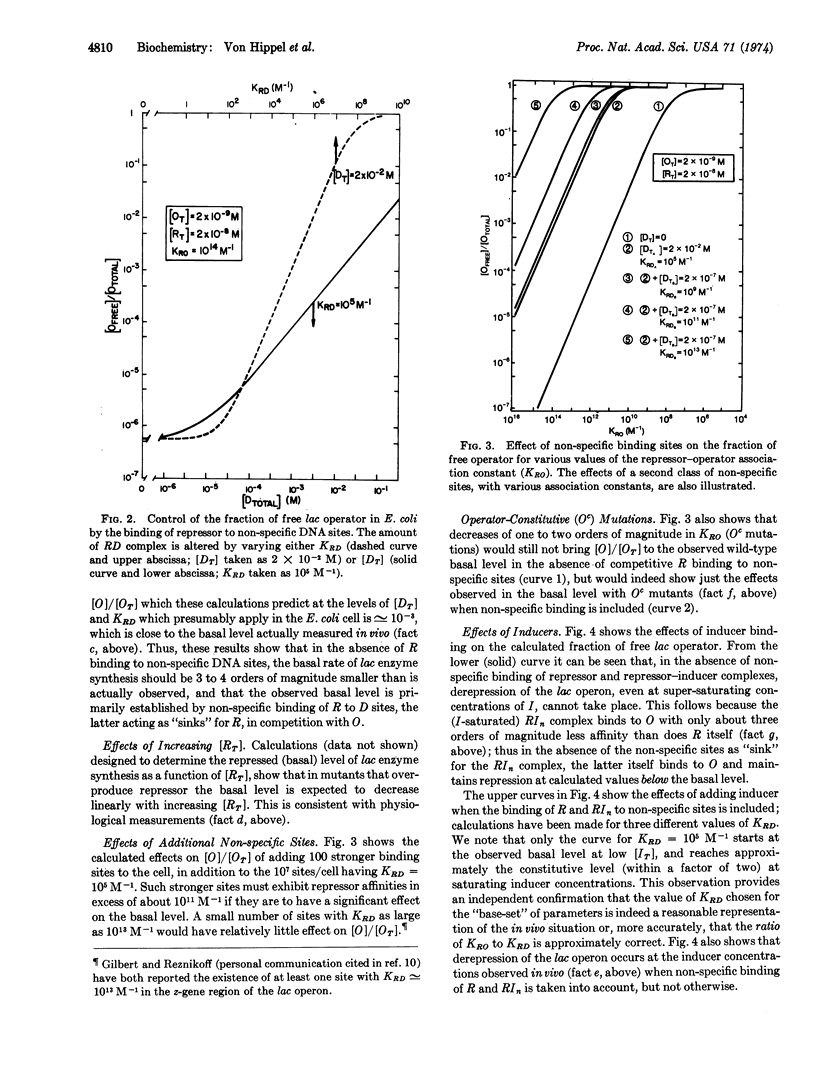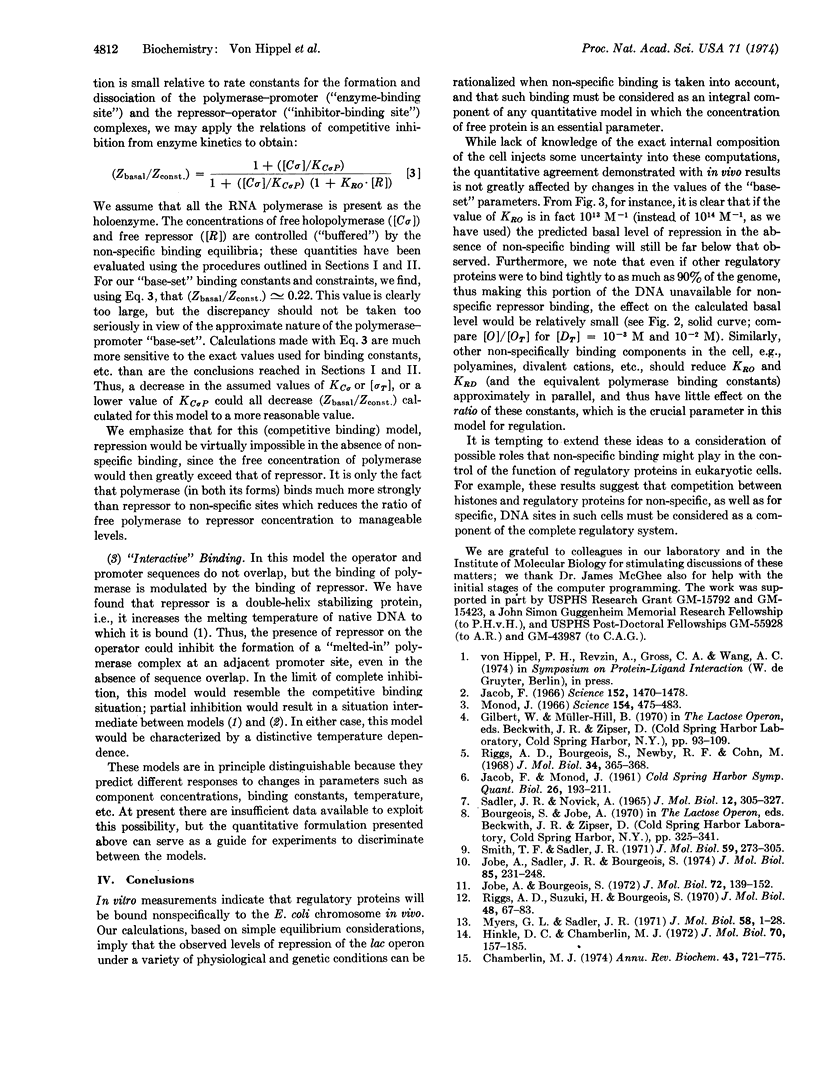Abstract
The regulatory system of the lactose operon has been “modeled” by a set of mass action equations and conservation constraints which describe the system at equilibrium. A “base-set” of values of binding constants and total component concentrations has been assembled from the available experimental data, and the simultaneous equations solved by computer procedures, to yield equilibrium concentrations of all the relevant molecular species. Considering the operator-repressor-inducer system alone, it is shown that the in vivo basal and induced (derepressed) levels of lac enzyme synthesis in both wild-type and certain mutant Escherichia coli can be accounted for only if binding of repressor and repressor-inducer complexes to non-specific DNA sites is included in the calculations as an integral component of the ovrall control system. A similar approach was applied to the RNA polymerase-promoter system to show that sigma factor may modulate the general level of transcription in the cell by “inducing” polymerase off non-specific DNA binding sites, thus making it available to promoters. Competitive and non-competitive models for the interaction of repressor and polymerase at the lac operon can, in principle, be distinguished by these computational procedures, though data sufficient to permit unambiguous differentiation between the models are not available at this time. However, for any competitive binding model the results show that repression in the entire (operator-repressor-RNA polymerase-lac promoter) system can occur only because non-specific binding of the regulatory proteins reduces the concentration of free polymerase, relative to that of repressor, to appropriate levels.
Keywords: lac repressor, DNA-protein interactions, RNA polymerase, repressor-inducer complexes
Full text
PDF




Selected References
These references are in PubMed. This may not be the complete list of references from this article.
- Chamberlin M. J. The selectivity of transcription. Annu Rev Biochem. 1974;43(0):721–775. doi: 10.1146/annurev.bi.43.070174.003445. [DOI] [PubMed] [Google Scholar]
- Hinkle D. C., Chamberlin M. J. Studies of the binding of Escherichia coli RNA polymerase to DNA. I. The role of sigma subunit in site selection. J Mol Biol. 1972 Sep 28;70(2):157–185. doi: 10.1016/0022-2836(72)90531-1. [DOI] [PubMed] [Google Scholar]
- Jacob F. Genetics of the bacterial cell. Science. 1966 Jun 10;152(3728):1470–1478. doi: 10.1126/science.152.3728.1470. [DOI] [PubMed] [Google Scholar]
- Jobe A., Bourgeois S. The lac repressor-operator interaction. VII. A repressor with unique binding properties: the X86 repressor. J Mol Biol. 1972 Dec 14;72(1):139–152. doi: 10.1016/0022-2836(72)90075-7. [DOI] [PubMed] [Google Scholar]
- Jobe A., Sadler J. R., Bourgeois S. lac Repressor-operator interaction. IX. The binding of lac repressor to operators containing Oc mutations. J Mol Biol. 1974 May 15;85(2):231–248. doi: 10.1016/0022-2836(74)90362-3. [DOI] [PubMed] [Google Scholar]
- Monod J. From enzymatic adaptation to allosteric transitions. Science. 1966 Oct 28;154(3748):475–483. doi: 10.1126/science.154.3748.475. [DOI] [PubMed] [Google Scholar]
- Myers G. L., Sadler J. R. Mutational inversion of control of the lactose operon of Escherichia coli. J Mol Biol. 1971 May 28;58(1):1–28. doi: 10.1016/0022-2836(71)90229-4. [DOI] [PubMed] [Google Scholar]
- Riggs A. D., Bourgeois S., Newby R. F., Cohn M. DNA binding of the lac repressor. J Mol Biol. 1968 Jul 14;34(2):365–368. doi: 10.1016/0022-2836(68)90261-1. [DOI] [PubMed] [Google Scholar]
- Riggs A. D., Suzuki H., Bourgeois S. Lac repressor-operator interaction. I. Equilibrium studies. J Mol Biol. 1970 Feb 28;48(1):67–83. doi: 10.1016/0022-2836(70)90219-6. [DOI] [PubMed] [Google Scholar]
- SADLER J. R., NOVICK A. THE PROPERTIES OF REPRESSOR AND THE KINETICS OF ITS ACTION. J Mol Biol. 1965 Jun;12:305–327. doi: 10.1016/s0022-2836(65)80255-8. [DOI] [PubMed] [Google Scholar]
- Smith T. F., Sadler J. R. The nature of lactose operator constitive mutations. J Mol Biol. 1971 Jul 28;59(2):273–305. doi: 10.1016/0022-2836(71)90051-9. [DOI] [PubMed] [Google Scholar]


